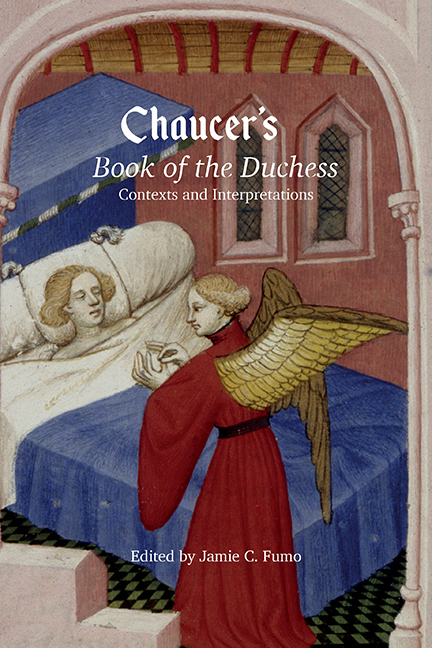Book contents
- Frontmatter
- Contents
- List of Illustrations
- Acknowledgments
- List of Contributors
- Abbreviations and Editions
- Introduction: Reopening the Book of the Duchess
- I Books and Bodies
- II The Intertextual Duchess
- 5 Alcyone's Grave: Inscription and Intertextuality in Chaucer, Spenser, and Ovid
- 6 Tribute to a Duchess: The Book of the Duchess and Machaut's Remede de Fortune
- 7 ‘Hyt am I’: Voicing Selves in the Book of the Duchess, the Roman de la rose, and the Fonteinne Amoureuse
- 8 ‘Counterfeit’ Imitatio: Understanding the Poet-Patron Relationship in Machaut's Fonteinne amoureuse and Chaucer's Book of the Duchess
- 9 The Shock of the Old? The Unsettling Art of Chaucer's Antique Citations
- 10 Response: The Book of the Duchess, Guillaume de Machaut, and the Image of the Archive
- Bibliography
- Index
- Miscellaneous Endmatter
8 - ‘Counterfeit’ Imitatio: Understanding the Poet-Patron Relationship in Machaut's Fonteinne amoureuse and Chaucer's Book of the Duchess
from II - The Intertextual Duchess
Published online by Cambridge University Press: 18 April 2018
- Frontmatter
- Contents
- List of Illustrations
- Acknowledgments
- List of Contributors
- Abbreviations and Editions
- Introduction: Reopening the Book of the Duchess
- I Books and Bodies
- II The Intertextual Duchess
- 5 Alcyone's Grave: Inscription and Intertextuality in Chaucer, Spenser, and Ovid
- 6 Tribute to a Duchess: The Book of the Duchess and Machaut's Remede de Fortune
- 7 ‘Hyt am I’: Voicing Selves in the Book of the Duchess, the Roman de la rose, and the Fonteinne Amoureuse
- 8 ‘Counterfeit’ Imitatio: Understanding the Poet-Patron Relationship in Machaut's Fonteinne amoureuse and Chaucer's Book of the Duchess
- 9 The Shock of the Old? The Unsettling Art of Chaucer's Antique Citations
- 10 Response: The Book of the Duchess, Guillaume de Machaut, and the Image of the Archive
- Bibliography
- Index
- Miscellaneous Endmatter
Summary
As is well known, Chaucer's rendition of the tale of Ceyx and Alcyone in the frame-tale of The Book of the Duchess departs from its sources in a small, but significant, detail with respect to the role of Morpheus. Guillaume de Machaut's Fonteinne amoureuse, a known central source for the Duchess, has Morpheus adopt Ceyx's shape as a simulacrum, as happens in Machaut's sources (Ovid's Metamorphoses and the Ovide moralise). Chaucer, on the other hand, has Morpheus go to the sea in which Ceyx has been drowned, ‘take up Seys body the kyng, / That lyeth ful pale and nothyng rody / … [and] crepe into the body / And doo hit goon to Alcione’ (BD 142–5). Instead of merely looking like Ceyx, Morpheus reanimates Ceyx's dead corpse to ferry the message of his death to Alcyone. Chaucer further emphasizes his curious departure from his sources by reiterating it some lines later: Morpheus ‘[t]ook up the dreynte body sone / And bar hyt forth to Alcione’ (195–6). Furthermore, Ceyx's body, controlled from inside by Morpheus, speaks before Alcyone's bed while she sleeps, rather than from inside her dream as in Chaucer's sources. Chaucer thus insists on adding an uncomfortable authenticity to the scene: instead of hearing an image in a dream, Alcyone hears her actual husband communicate with her, but, rather than merely looking like Ceyx, he is being awkwardly reanimated and manipulated from the inside out.
The differences in Machaut's and Chaucer's treatment of Morpheus’ role in the Ceyx and Alcyone tale extend to that tale's subsequent relationship to the larger plot of both works. In the Fonteinne, the Ceyx and Alcyone story is rendered within a complainte spoken aloud by a lovesick nobleman, which the text's protagonist, Guillaume, overhears and copies down verbatim. Later, he presents this perfect rendition of the nobleman's words to him and garners the prince's favor, friendship, and, most importantly, his patronage. As an anagram in the Fonteinne reveals, moreover, the nobleman in question represents Machaut's real-life patron John of Berry.
- Type
- Chapter
- Information
- Chaucer's Book of the Duchess , pp. 157 - 176Publisher: Boydell & BrewerPrint publication year: 2018



